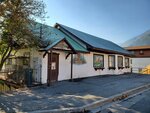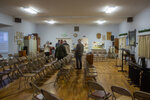


LEAVENWORTH – This winter, the Greater Leavenworth Museum has made huge strides in its mission to expand its space into the Chumstick Grange, allowing it more exhibit options and saving a critical piece of Leavenworth’s history.
“This is the right thing to do for this community, because this is a community asset that if we don't do something with it now, it stands a really big chance of just being gone forever,” said Matt Cade, Board President of the Upper Valley Historical Society (UVHS).
At the end of 2023, The Chumstick Grange completed two critical assessments of the property as part of a necessary feasibility study: a geotechnical and a structural survey. UVHS was able to fund part of the surveys through grant support from the Chelan Douglas Port Authority.
Although the building must go through more assessments in order to complete the feasibility study, these two surveys were essential requirements for the project to move forward sustainably and preserve the site’s historical significance.
According to previous Echo reporting, the building dates back to 1910, when it served as a train depot for the Great Northern Railway. Since the 1930s, the building has been home to the Chumstick Grange. The concept of the grange is an integral part of the nation’s agricultural history, dating back to 1867. The movement was started just after the Civil War as a way to educate and connect farmers.
“The purpose of the formation of the grange was to recover as much information as possible that had been lost to the war due to farmers being killed fighting the war,” said Paul Gray, a former UVHS Board Member who serves on the Chumstick Grange Executive Committee.
For over 150 years, granges have served as community hubs, legislative advocates, and educational resources for young farmers. In recent decades, however, active membership of the Chumstick Grange has been in rapid decline. Gray says there are about 50 names on the member list, but only four or five are still actively participating.
“The Chumstick Grange is faced with an aging out problem. It's also faced with people like myself who [are] committed to so many other things…we don't have enough people to go around to start new programs,” said Gray.
The arrangement with the museum is inspired by other granges, who are seeking similar solutions to the same challenge. By renting or leasing out the space, the granges are able to find financial stability while maintaining a location for its meetings and events. Although the space will not remain quite the same as it was, Gray says without it, there’s only one word to describe the building’s future: “bleak.”
“As [members age] out, to know that it's in good hands and going to continue to be used by the community that they know and love, I think, is a good feeling,” said Cade.
With the expansion, the Leavenworth Museum would stay in its current location above the Nutcracker Museum. The Chumstick Grange Hall would be a secondary location for more exhibits and venue space.
On Feb. 5, community members and UVHS leaders walked through the Chumstick Grange to visualize the possibilities. Although nothing is set in stone, Cade discussed the possibility of rotating exhibits that could feature railroad history or rock climbing in the area. There was also discussion of adding on to the building to include the fully-restored 1939 Leavenworth fire truck or turning the adjacent outdoor space into an amphitheater. The space could also be used as a community venue, hosting interactive programs such as P'Squosa storytelling, said Cade.
“It's going to hopefully have that multiplex feature…so on weekends it's used for people that visit and can enjoy more of the historical side of things, and then during the week we'd like to think it could be changed over so that it can be used for community functions,” said Cade.
It will likely be a few years before the expansion is complete. UVHS is still in discussion about how the space will be utilized. The group also needs to raise additional funds to cover the rest of the feasibility study and necessary modifications.
To donate, visit leavenworthmuseum.org/support. Those who are interested in getting involved can email matt@leavenworthmuseum.org.
Taylor Caldwell: 509-433-7276 or taylor@ward.media
Comments
No comments on this item Please log in to comment by clicking here